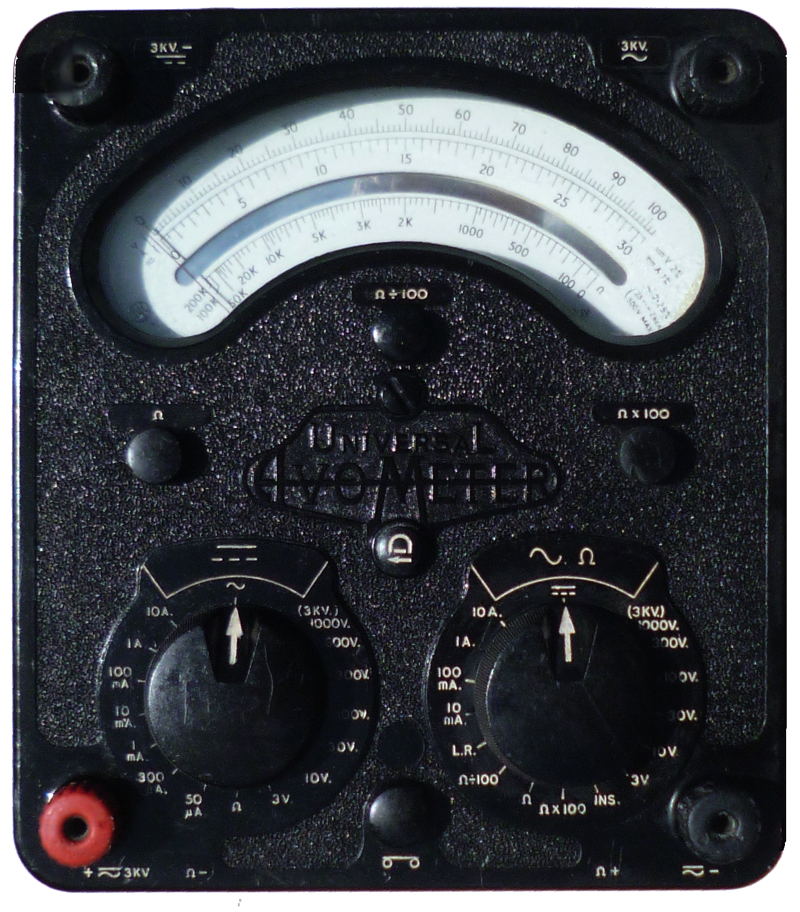
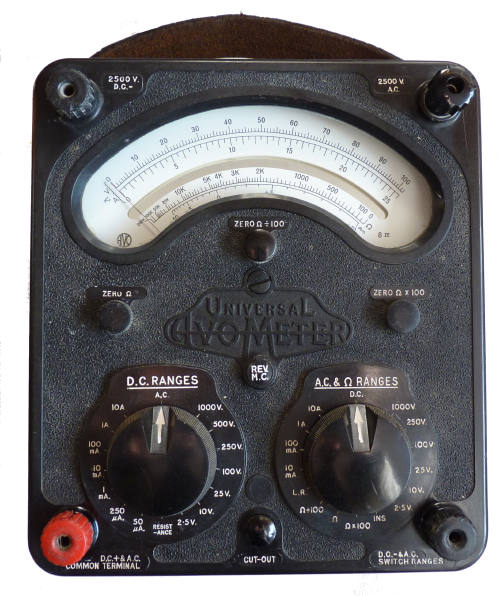
AVO Model 9 MkIV (1972?)
repaired and working (The second image is the equivalent model 8
MkIV)
The Universal AVOmeter model 8 was the most ubiquitous multimeter in the AVO range which started life back in 1923, and although it was initially a DC-only instrument many of its features remained almost unaltered right through to the last Model 8 of 2008. In particular the mirror scale, the "smiley" meter scale, the two switches and two terminals. AVO multimeters are renowned for their reliability and robustness, the early incorporation of a mechanically operated cut out linked to the meter movement and the two switch range selection system have endeared these meters to generations of electrical and electronic engineers. By 1965, the company had already created over one million AVOmeters. The firm also produced a range of smaller multimeters, the AVO Minor and later the AVO Multiminor as well as a number of special instruments such as the Heavy Duty model. Production of the iconic model 8 meter ceased in 2008. Though known for their Avometer general purpose multimeters, they made a wide range of test gear including valve testers, oscillators and light meters. You will find more information here about these instruments and other similar models. AVO also produced a range of smaller multimeters which are described here.
The Avometer Model 9 Mk. 4 which was introduced in 1969 is a high
sensitivity instrument for the measurement of voltage, current and
resistance. It is designed primarily for the electronics engineer and
is similar in specification to the Avometer Model 8 Mk. 4. The Model 9
incorporates all the traditional design features of the Model 8
including the Avo automatic cut-out mechanism and reverse moving coil
facility.
The Model 9 is, however, scaled in basic units of 10 and 3 and all
range switches, controls and terminals are identified by graphical
symbols, which in general follow the requirements of the International
Electrotechnical Commission.
The protective devices incorporated in the Model 8 Mk. 4 are all
retained and an insulation resistance range now enables measurements up
to 600A to be made using a range of external shunts. The decibel scale
is, however, not included on this instrument.
SPECIFICATION
A.C. 10mA to 10A f.s.d. in 4 ranges.
D.C, 50uA to 10A f.s.d. in 7 ranges.
A.C. 3V to 3000V f.s.d. in 7 ranges.
D.C. 3V to 3000V f.s.d. in 8 ranges.
Resistance: 0 to 20M a (first indication 0.5 ohm
Accuracy: A.C. Voltage and Current �2.25% of f.s.d.
D.C. Voltage �2% of indication. D.C. Current �1% of f.s.d.
Sensitivity: A.C. Voltage Ranges 2000 ohms/volt (10V upwards).
D.C. Voltage Ranges 20,000 ohms/volt (all ranges).
Size: 204 x 185 x 115mm.
Weight: 2.85kg.
Price each �34.80 (in 1970)


AVO Model 9 MkIV (1972?)
repaired and working (The second image is the equivalent model 8
MkIV)
Both models have 37.5 uA movements and are housed in olive green
thermoplastic cases. As can be seen the front panel, range selection
switches and meter scale markings are the same apart from the switch
and scale markings. The less common model 9 does not have a dB scale
and has international symbol markings presumably to suit the export
market. As can be seen from the pictures they are almost identical
internally, The values of the voltage multipliers and shunt resistors
will clearly be different.
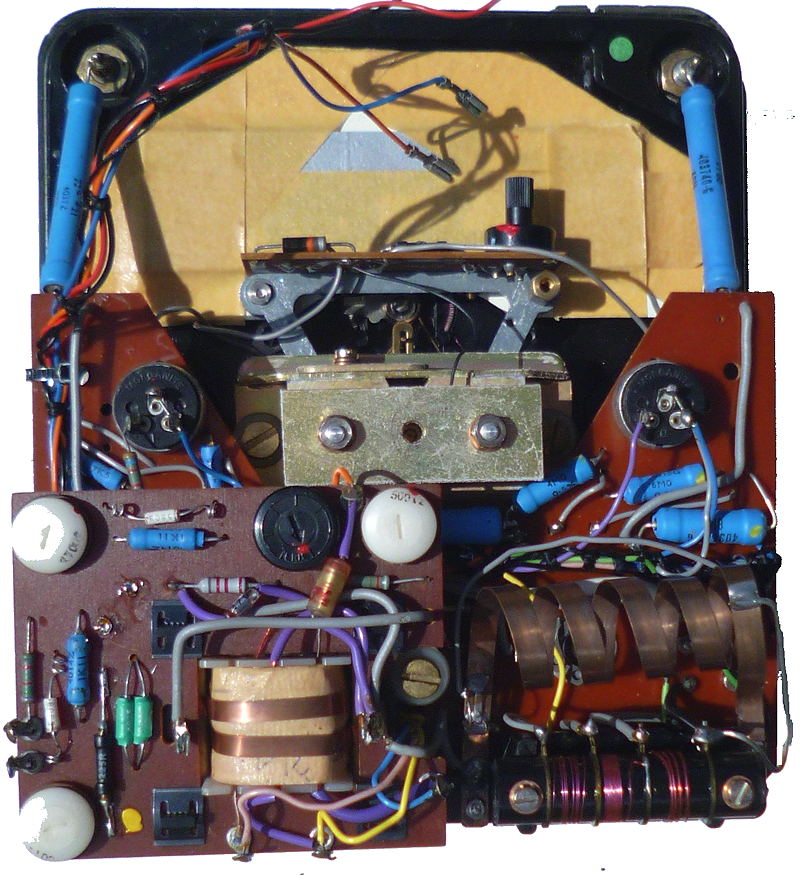
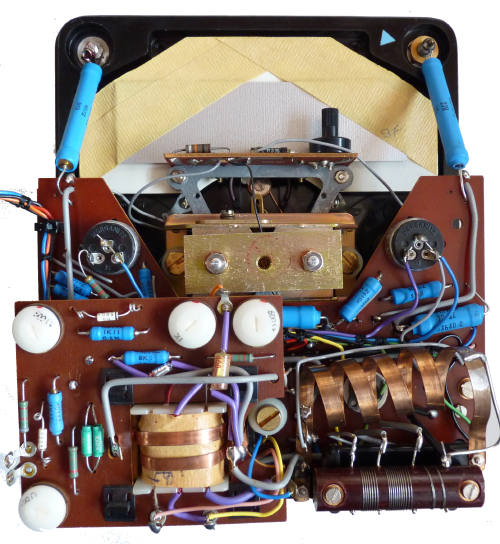
AVO Model 9 interior AVO Model 8 MkIV interior
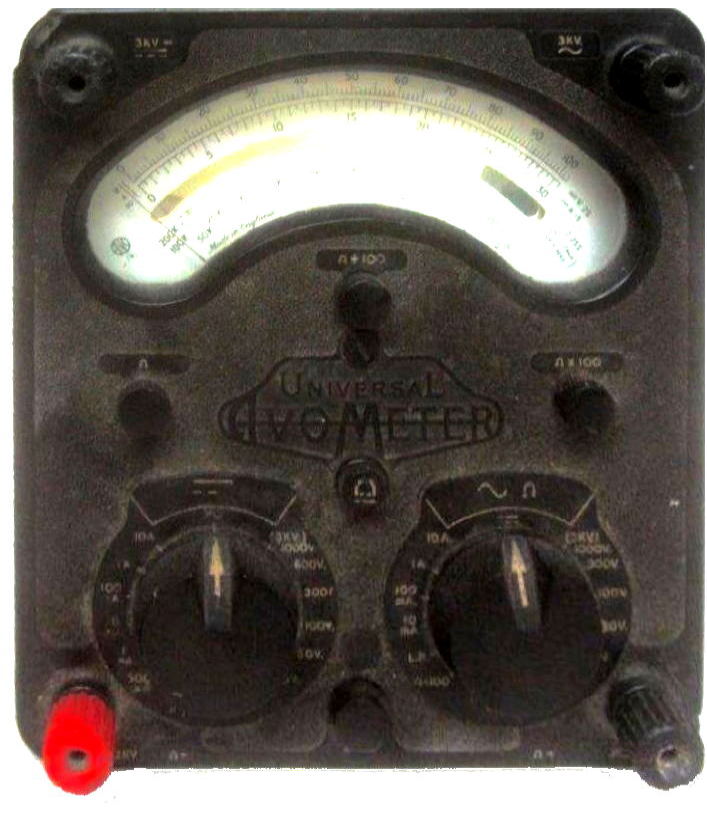
This is the condition it was in when I bid
for it on eBay, dirty, no carrying strap, cracked case, broken corner
to front panel and
defective mechanical cutout. After washing the front panel, filling the
lettering with water based emulsion paint, I repaired the top LH corner
with a 2 part epoxy adhesive mixed with black powder filler. The cracks
in the casing were repaired with "super glue" and a leather strap from
a donor AVO was fitted with screws nuts and washers.
What is it worth? You should be able to buy a model 9 MkIV
for �20- 30. Bear in mind that the earlier model MkII is eqully as good
and has more robust switches.
How old is it? Most AVO meters can be dated from the last 3
or 4
digits of the serial number under the right hand end of the scale. The
serial number on later models have a self adhesive sticker (somettimes
absent or defaced) on the right
hand side of the case.
These define the month and year of manufacture.
Variations
Avometer Model 9
Avometer Model 9sx
Avometer Model 9x
Avometer Model 9s
Avometer Model 9 Mk 2
Avometer Model 9sx Mk 3
Avometer Model 9 Mk 4
Batteries Early models of the AVO 8 use the BLR121
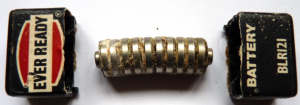
Later models use the BLR154 type, both are 15volt and rated at
40mAh.
BLR121 Height: 36mm. Width: 15mm. Length: 26 mm.
BLR154 Height: 34mm. Diam: 15mm.
When Ever Ready stopped manufacture AVO came up with a novel solution in the form of a miniature voltage converter [type VC1] Although these are reputed to be as rare as 'hen's teeth' I have one of these and you can have a look at it HERE
Where do you buy a replacement for the type BLR121 15 volt Battery? http://www.maplin.co.uk/ then search for battery blr121 which cost cost � 9.99 when I last looked. http://www.cellpacksolutions.com is another source for batteries, they will even make up special batteries to your own specification.
Another suggestion Purchase from your local "Pound Shop" a card of assorted button cells and select ten of them (they need not be the same size). Cut a small block of wood 34 mm long and drill an 8mm hole through it. Cut a slot in one end and glue a thick piece of wire into it as a contact. Find a small helical spring (mine was from an old lamp holder) Take a narrow piece of masking tape and tape your ten cells into two bundles, insert them into the wood block with the spring in between. You can stop the cells from popping out when inserting the block with a thin piece of metal. Alternatively use the plastic casing from a BLR21 and insert a new set of ten cells kept in place with adhesive tape.
Can I fix it myself?
One problem I have experienced and have been asked about in the past is that the meter works on everything other than the resistance range[s]. If the contacts for the fuse or either battery are corroded the high resistance would prevent the instrument from being zeroed or even reading at all. It may be that the contacts which are meant to be closed on the resistance ranges are dirty and causing erratic readings. After checking the contacts which mate with the batteries for corrosion and the fuse and it's holder. If none of the above work the contacts on the switches or the zero rheostat may be at fault. A piece of thin card soaked in switch cleaner moved back and forth between the switch contacts may solve the problem.
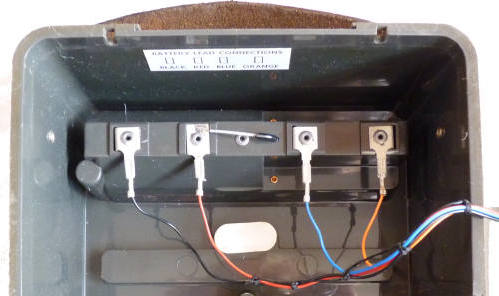
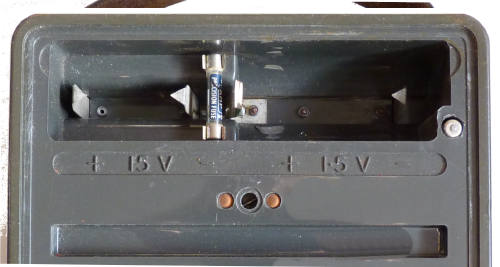
AVO Model 9 Mk4 battery compartments and connections to meter,
the model 8 Mk4 is the same
History AVO Ltd. used to be at Avocet House, 92-96 Vauxhall Bridge Road, London, SW1 and was a member of the Metal Industries Group of companies. Though known for their Avometer general purpose multimeter, they made a wide range of test gear including valve testers. The Acton Lane works closed down at about that time - around 1986. The current range of products can bee seen at: http://www.avointl.com/ The firm now called Megger Ltd is based at: Archcliffe Road, Dover, Kent, CT17 9EN, United Kingdom.
circuit diagram Mk4 (pdf file)click
here for diagram
For further information have a look at my pages on the model 7 AVO and Test Meter No1 here and here

